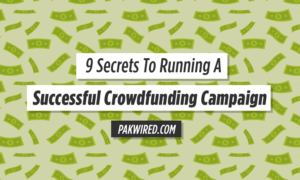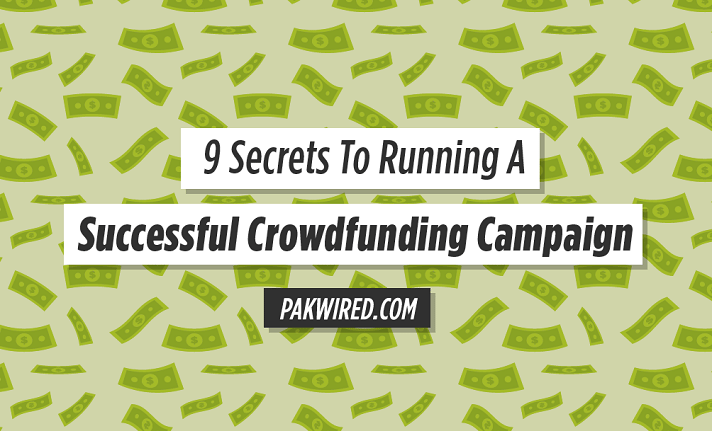Although there is no clear way to guarantee any crowdfunding endeavor will be a success, there are certain tactics you can implement to increase your chances. To help any aspiring crowdfunders, here are nine tips you can use to ensure your campaign is optimized for success!
Does Your Product Solve A Problem?
Many crowdfunding success stories have revolved around novel products and services that solved problems that many members of the public dealt with. For instance, the Coolbox Toolbox, which raised over $370,000 on Indiegogo, was successful as it fulfilled a need many people had – to own a functional toolbox with the relevant tools stored inside. In addition, it also featured innovations like an internal battery, USB ports, Bluetooth speakers and a three-way splitter for tools.
“Your responsibility is to produce a solution to a problem,” advises Adam Sager, creator of home security device Canary, which raised $1.9 million on Indiegogo. “You need to be able to tell people right away how the product is going to solve a real problem that they have.”
Photographer Peter Dering who created the Capture Camera Clip, which received $800,000 on Kickstarter, created the Clip because he was bothered by his DSLR hanging around his neck and banging into things whilst he travelling around Asia. “I thought this was a problem enough people had,” he says, “and that my idea for a product could solve it. Identifying a problem, and designing a solution that is solid, equals success.”
However, it’s important that you don’t jump too far ahead of the curve. “If your idea is too far ahead of its time, you’ll have to spend resources telling people why they need it,” says John Van Den Nieuwenhuizen, whose wireless portable speaker Hidden Radio, raised more than $500,000 on Kickstarter. “When we came up with the idea for Hidden Radio back in 2008, we didn’t invent the category. There were Bluetooth speakers already on the market, but they weren’t attractive and didn’t sound good. We felt we could make a beautiful design that had better sound.”
Be Prepared
Although crowdfunding may be useful for collecting innovative ideas and diverse perspectives on a project, prospective pledgers may not want to invest if your campaign appears underdeveloped.
Phil Bosua raised $1.3 million on Kickstarter whilst crowdfunding for the Lifx LED Smart Bulb, and suggests you do your homework before launching a campaign. “Every hour of planning you do before the campaign saves you 100 hours of work after it,” he told Forbes back in January 2014.
John Van Den Nieuwenhuizen began sketching his portable Bluetooth speaker five years before he began crowdfunding. “You need to do your homework,” he says. “Once my partner and I had a design we liked, we submitted it to some design blogs. The response was very positive, with people asking how they could buy it, and all we had at that point was a rendering. We made our first prototype with a trip to the hardware store. It took us a year of looking in the U.S. and Asia to find the right manufacturer. But by the time we launched on Kickstarter, we were literally ready to begin production if we got the funds.”
Peter Dering suggests that you have the resources to create and distribute your product long before beginning a campaign. “You’ve got to have an e-commerce site up and running, a supply chain and distribution network, and way to handle fulfillment and warehousing,” Dering says. “Miss any one of these, and you’re dead. You need to be prepared to make your backers happy, and getting as many ducks in a row as you can before starting the campaign, allows you to ship your product to them quickly.”
You may also want to ask for advice from individuals and companies who have some experience in crowdfunding campaigns before you launch your own. One crowdfunder who did this was Gabriel Bestard-Ribas who created the Goji Smart Lock and received more than $300,000 on Indiegogo. “I got advice from people who had run successful campaigns, asking for feedback on my idea,” he says. “But I also talked to people who had failed at crowdfunding. I learned what things to avoid, which is important.”
Make Crowdfunding Your Main Priority
Running a crowdfunder can be time consuming, but the more effort you put in the more you’re likely to get out. “It’s not only full-time for one person, it’s full-time for everyone in the company,” says Jonas Gyalokay, who created wireless HDMI streaming dongle AIRTAME, which raised $1.2 million on Indiegogo.
Sager adds: “When we ran our campaign, the entire team was 100% focused on crowdfunding. We sent out multiple surveys to our backers. I personally answered 3,000 emails in the first week.”
Set Realistic Goals
If you’ve never entered into the crowdfunding arena before, you may be unaware that some sites have their own rules when it comes to goals. For instance, you do not keep any of the money you raise on Kickstarter if you do not reach your target. However, if you set a realistic goal, you can continue to raise money after you’ve reached it.
Other sites tend to be more lenient, although there are also drawbacks in these cases. Indiegogo allows you to keep any money you raise; however if you do not reach your goal they will take 9% of your total. So, if you manage to get $10,000 they will take $900.
Due to these factors, you may want to keep your original target on the smaller side. Plus, people love to support a winner, so demolishing your original goal by a significant percentage right at the beginning will encourage people to back you.
Look Like The Real Deal
The presentation of your company and/or product has a huge influence on whether you are successful. As Bestard-Ribas says, people support crowdfunding “because they are drawn to a vision. One they want to engage with. Many people think of their campaign as just selling a product. But you’re really launching your company to the world.”
The Coolest Cooler managed to garner $13 million on Kickstarter, possibly due to their fantastic page which featured effective audio, images and video. Writer and entrepreneur Seth Godin is particularly fond of video media in crowdfunding campaigns. He says: “There’s something about the medium that makes the video even more important than you’d think.”
Videos are able to give your audience all the information they need, as well as a view of your product in action. “We crafted a very focused message and presented the product to show how it could impact people’s lives in a direct way,” says Adam Sager. “We didn’t start by talking about features. Instead we led with how we were solving a problem. It’s also important to make your team visible. Be very transparent and let potential backers know who you are. Trust is a big part of crowdfunding.”
However, videos can be difficult to craft especially if you lack the time, resources and skills necessary to create a high-quality feature. If you’d like to create a video for your campaign but fear it may look amateur, it may be worth paying for professionals to help you.
Communicate With Your Supporters
Despite the manner of the news, it’s important that you keep your supporters informed. Ensure you post on your crowdfunding page regularly, even after the campaign has closed.
“We believe that if we can have a dialogue with the market, we can be successful,” says Gavin Fish, whose Geek Pulse portable DAC raised $1.17 on Indiegogo. “We decided to host a separate forum for our backers, to continue the conversation beyond the crowdfunding campaigns.”
Conversing with your supporters can also lead to advances in the product itself. “Feedback can drive product design,” says Dering. “We sent out a Kickstarter survey with a choice of A or B, and our backers overwhelmingly picked a winner,” he recalls.
Create An Accessible Media Page
If you’re aiming to garner attention from the press you will need to create a website and press materials for journalists to utilize. If journalists cannot find the information they need in order to write a compelling article, chances are they will simply move onto another project.
You should also focus on press releases, perhaps even tours. The Star Citizen video game managed to acquire over $14 million via IgnitionDeck due to a press tour before they launched their campaign.
Be Strategic On Social Media
While you may be tempted to create accounts on every social media platform available in an attempt to reach as many potential investors as possible, this strategy may not work to your advantage.
“It’s getting more crowded,” Richard Swart, alternative finance researcher and scholar-in-residence in the Institute for Business and Social Impact at the University of California, Berkeley’s Haas School of Business says. “It’s becoming more difficult to attract interest.”
Instead of creating presences everywhere, pick social media platforms that are relevant to your niche and whose users will be interested in your project.
It’s also a good idea to customize your promotional materials for each social media platform. For example, indie band Bigtree Bonsai raised $6,956 on IgnitionDeck after starting #letsmakearecord on Twitter.
Jonas Gyalokay suggests that emails may also be a good marketing strategy. “We prepared 100 personal emails each to send out when we launched the campaign,” says Gyalokay. “We made sure each one was personal and had a good dose of humility, while stating how important this project was to us and our lives. And of course we ended with a strong call to action.”
If you don’t have the skills or time necessary to carry out a social media campaign effectively, you may want to consider using a crowdfunding marketing agency such as Agency 2.0.
Reward Your Supporters
Although this may support the idea that there is no such thing as a selfless act, it will encourage people to support your project. If you offer a reward scheme for each price point, backers are a lot more likely to get involved regardless of how much they can pledge.
The Back To The Roots AquaFarm raised $248,873 using a tier system of rewards for everyone, from $1 where donators received behind-the-scenes updates, to $10,000 pledgers who got the chance to host an educational seminar in their community.
You can also implement a reward scheme for those who simply share you campaign; Indiegogo even offers a specific referral programme. If you’re willing to reward people for sharing your project, they’re a lot more likely to do it and it will only contribute to your social media presence.
Like most other business ventures, crowdfunding takes planning, effort and time, but if you want your project to succeed and are willing to go the extra mile, you will certainly reap the rewards.


